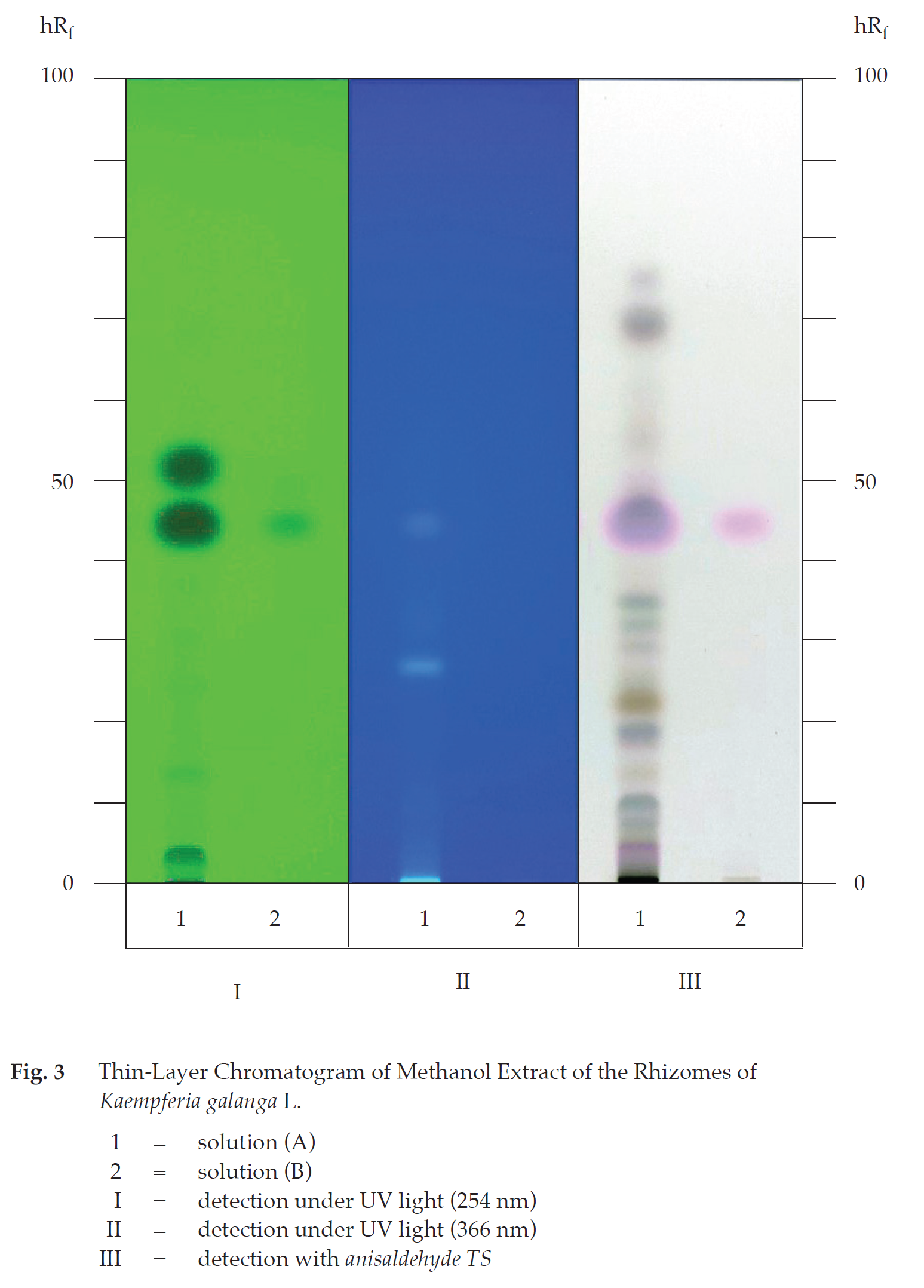ตำรามาตรฐานยาสมุนไพรไทย
Thai Herbal Pharmacopoeia
สำนักยาและวัตถุเสพติด กรมวิทยาศาสตร์การแพทย์ กระทรวงสาธารณสุข
Bureau of Drug and Narcotic, Department of Medical Sciences, Ministry of Public Health(Tinospora crispa (L.) Hook.f. & Thomson)
(Nelumbo nucifera Gaertn.)
(Centella asiatica (L.) Urb.)
(Centella Dry Extract)
(Centella Cream)
(Mesua ferrea L.)
(Piper sarmentosum Roxb.)
(Piper sarmentosum Roxb.)
(Pterocarpus santalinus L. f.)
(Santalum album L.)
(Senna tora (L.) Roxb.)
(Senna alata (L.) Roxb.)
(Senna Alata Tea)
(Piper retrofractum Vahl)
(Myristica fragrans Houtt)
(Andrographis paniculata (Burm. f.) Nees)
(Andrographis Capsules)
(Allium ascalonicum L.)
(Ocimum tenuiflorum L.)
(Curcuma longa L.)
(Turmeric Capsules)
(Turmeric Dry Extract)
(Turmeric Dry Extract Capsules)
(Arcangelisia flava (L.) Merr.)
(Curcuma sp.)
Harrisonia perforata (Blanco) Merr.
(Aristolochia pierrei Lecomte)
(Zingiber officinale Roscoe)
(Ginger Capsules)
(Ginger Tea)
(Cassia fistula L.)
(Nardostachys jatamansi (D. Don) DC.)
(Angelica sinensis (Oliv.) Diels)
Artemisia annua L.
(Ligusticum sinense Oliv. cv. Chuanxiong)
(Neopicrorhiza scrophulariiflora Pennell)
(Atractylodes lancea (Thunb.) DC.)
(Aucklandia lappa Decne)
(Terminalia chebula Retz.)
(Angelica dahurica (Hoffm.) Benth. & Hook. f. ex Franch. & Sav. var. dahurica)
(Kaempferia parviflora Wall. ex Baker)
(Hibiscus sabdariffa L.)
(Roselle Tea)
(Allium sativum L.)
(Zingiber zerumbet (L.) Sm.)
(Wurfbainia testacea (Ridl.) Škorničk.& A. D. Poulsen)
(Cannabis sativa L.)
(Myristica fragrans Houtt)
(Dracaena cochinchinensis (Lour.) S. C. Chen)
(Ficus racemosa L.)
(Hyptis suaveolens (L.) Poit.)
Clerodendrum indicum (L.) Kuntze
(Phyllanthus emblica L.)
(Citrus hystrix DC.)
(Citrus hystrix DC.)
(Areca catechu L.)
(Momordica charantia L.)
Moringa oleifera Lam.
(Aegle marmelos (L.) Corrêa)
(Solanum trilobatum L.)
(Morus alba L.)
Gynostemma pentaphyllum(Thunb.)
Makino
(Clinacanthus nutans (Burm. f.) Lindau)
(Cissus quadrangularis L.)
(Mimusops elengi L.)
(Zingiber montanum (J. König) Link. ex A. Dietr.)
(Piper betle L.)
(Capsicum annuum L.)
(Capsicum Oleoresin)
(Capsicum Gel)
(Piper nigrum L.)
(Piper nigrum L.)
(Eurycoma longifolia Jack)
(Thunbergia laurifolia Lindl.)
(Piper wallichii (Miq.) Hand.-Mazz.)
Senna garrettiana (Craib) H. S. Irwin & Barneby
(Terminalia bellirica (Gaertn.) Roxb.)
(Terminalia chebula Retz.)
(Caesalpinia bonduc (L.) H. Roxb.)
(Tarlmounia elliptica (DC.) H. Rob., S. C. Keeley, Skvaria & R. Chan)
(Hog Creeper Vine Dry Extract Capsiles)
(Hog Creeper Vine Dry Extract)
(Brachypterum scandens (Roxb.) Miq.)
(Lepidium sativum L.)
(Nigella sativa L.)
(Cuminum cyminum L.)
(Foeniculum vulgare Mill.)
(Plantago ovata Forssk.)
(Pimpinella anisum L.)
(Carum carvi L.)
(Anethum graveolens L.)
(Trachyspermum ammi (L.) Sprague)
Albizia procera (Roxb.) Benth.
(Acorus calamus L.)
(Tiliacora triandra (Colebr.) Diels)
Cyanthillium cinereum (L.) H. Rob.
(Orthosiphon aristatus (Blume) Miq.)
Murdannia loriformis (Hassk.) R. S. Rao & Kammathy
(Capparis micracantha DC.)
(Chrysopogon zizanioides (L.) Roberty)
(Cyperus rotundus L.)
(Cannabis sativa L.)
(Syzygium aromaticum (L.) Merr. & L. M. Perry)
(Boesenbergia rotunda (L.) Mansf.)
(Acanthus ebracteatus Vahl)
(Acanthus ilicifolius L.)
(Kaempferia galanga L.)
(Curcuma comosa Roxb.)
Betula alnoides Buch.-Ham. ex D. Don
Cannabis sativa L.
Carthamus tinctorius L
Mitragyna speciosa (Korth.) Havil
Mallotus repandus (Rottler) Müll. Arg
Azadirachta indica A. Juss. var. siamensis Valeton
Azadirachta indica A. Juss. var. siamensis Valeton
Punica granatum L.
Rhinacanthus nasutus (L.) Kurz
Baliospermum solanifolium (Burm.) Suresh
Curcuma aeruginosa Roxb
Boesenbergia kingii Mood & L. M. Prince
Senegalia rugata (Lam.) Britton & Rose
Acacia concinna (Willd.) DC.
Senegalia rugata (Lam.) Britton & Rose
Acacia concinna (Willd.) DC.
Senna alexandriana Mill. var. alexandriana
Cassia acutifolia Delile, Cassia angustifolia Vahl
Butea superba Roxb. ex Willd.
[Plaso superba (Roxb. ex Willd.) Kuntze, Rudolphia superba (Roxb. ex Willd.) Poir.
Pueraria candollei Graham
ex Benth. var. mirifica (Airy Shaw & Suvat.) Niyomdham
Streblus asper Lour.
Suregada multiflora (A. Juss.) Baill. (Gelonium
multiflorum A. Juss.
Plumbago zeylanica L.
Plumbago indica L.
Biancaea sappan (L.) Tod.
Ziziphus attopensis Pierre
Streblus asper Lour.
Justicia gendarussa Burm. f.
Enhalus acoroides (L. f.) Royle
Bridelia ovata Decne.
Tamarindus indica L.
Citrus × aurantiifolia (Christm.) Swingle
Garcinia mangostana L.
Blumea balsamifera (L.) DC
Persicaria odorata (Lour.) Soják
Zingiber montanum (J. König) Link ex A. Dietr.
Mammea siamensis (Miq.) T. Anderson
Citrus maxima (Burm.) Merr.
Citrus × aurantium L. ‘Som Sa’
Punica granatum L.
Rhinacanthus nasutus (L.) Kurz
Kaempferia Galanga Rhizome is the dried rhizome of Kaempferia galanga L. (K. humilis Salisb., K. latifolia Donn, K. plantaginifolia Salisb., K. procumbens Noronha) (Family Zingiberaceae), Herbarium Specimen Number: BKF 200905, DMSc 5307. Crude Drug Number : DMSc 1204.
Constituents Kaempferia Galanga Rhizome contains volatile oil, of which carvone, ethyl cinnamate, ethyl trans-4-methoxycinnamate, methyl cinnamate, and pentadecane are its major components. It also contains flavonoids (e.g., kaempferol).
Description of the plant (Figs. 1a, 1b) Perennial herb, up to 10 cm tall; pseudostem short, glabrous; rhizome pale green or greenish white inside, irregularly shaped, 2 to 3.5 cm long, 1 to 2.5 cm wide, with several tuberous roots, fragrant. Leaves simple, mostly 2, sessile or shortly petiolate, arising from pseudostem, spreading flat on ground, obliquely ovate or suborbicular, 6 to 14 cm long, 5 to 10 cm wide, apex mucronate or acute, base obtuse to cuneate, margin entire, chartaceous, deep green, upper surface glabrous, lower surface pubescent, veins prominent; leaf-sheath broad, thick and keeled, about 5 cm long, about 1 cm wide; ligule triangular, about 3 mm long, apex rounded, membranous, hairy. lnflorescence terminal on pseudostem, enclosed by imbricate leaf-sheaths, sessile; bract lanceolate, acuminate, 2 to 3 cm long, 0.7 to 1.3 cm wide, glabrous; bracteole tubular, 2 to 3 cm long, split to the base. Flowers 4 or more, irregular, bisexual; calyx 2 to 2.5 cm long, apex bifid, glabrous; corolla tube 3 to 4 cm long; lobes white, lanceolate; dorsal lobe 1.5 to 2 cm long, about 4 mm wide, hood-like, aristate; lateral lobes 1.4 to 1.8 cm long, about 4 mm wide, blunt; lateral staminodes petaloid, obovate-cuneate or oblanceolate, 1.5 to 2 cm long, 0.7 to 1.2 cm wide; labellum white with purple blotch at base, bilobed, each lobe obovate, about 1.8 cm long, about 1.3 cm wide, apex irregularly crenate; anther sessile, 3 to 4 mm long, anther crest 2 to 3 mm long, 4 to 5 mm wide, deeply bilobed, each lobe rounded or unequally toothed; ovary inferior, 3 to 4 mm long, about 2.5 mm wide, glabrous, 3-loculed, ovules many in each locule. Fruit a capsule, oblong, pericarp thin. Seed subglobose; aril lacerate.
Description Odour, characteristic; taste, spicy.
Macroscopical (Fig. 1a) Transverse and longitudinal slices, occasionally with whole rhizomes, varied in shape and size. Slices irregularly shaped, externally brownish to dark brown, some with rootlets or rootlet scars, fragile. Surface creamy to light brownish, starchy.
Microscopical (Figs. 2a, 2b, 2c) Transverse section of the rhizome shows scale leaf, periderm, cortex, and vascular tissue. Scale leaf: dark-brown thin sheet. Periderm: several layers of thin-walled rectangular storied corks. Cortex: collapsed parenchyma cells, lysigenous cavities, thin-walled polygonal parenchyma cells, some containing starch grains and/or oleoresin, and oil cells; pseudoendodermis, a layer of small rectangular cells with casparian strip, oil cells and thin-walled polygonal parenchyma cells, some with numerous starch grains and/or oleoresin. Vascular tissue: collateral bundles, scattered.
Kaempferia Galanga Rhizome in powder possesses the diagnostic microscopical characters of the unground drug. Storied cork in surface view and in sectional view, parenchyma containing starch grains, spiral and reticulate vessels are commonly observed. Parenchyma containing oleoresin and fragments of scale leaf are characteristic.
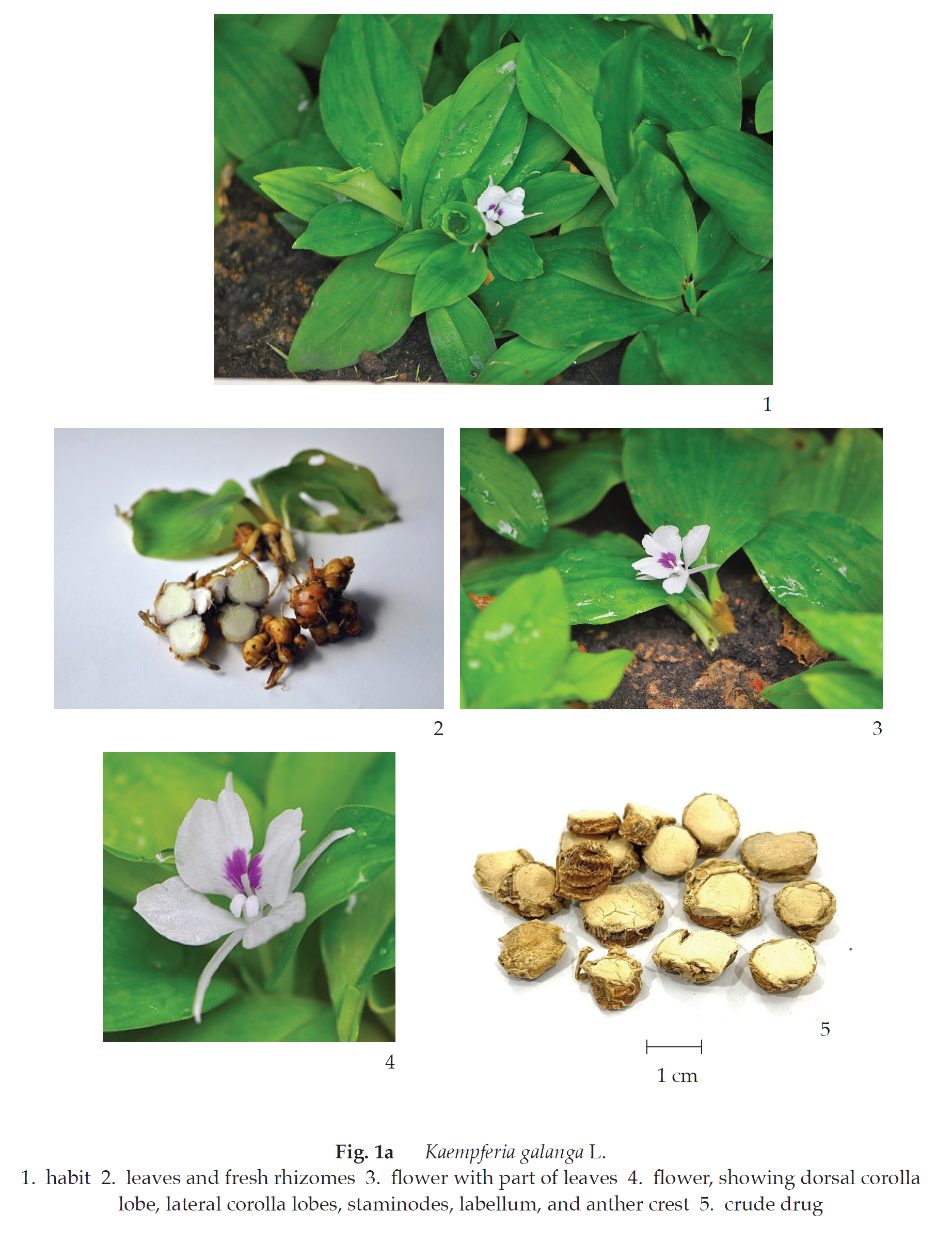
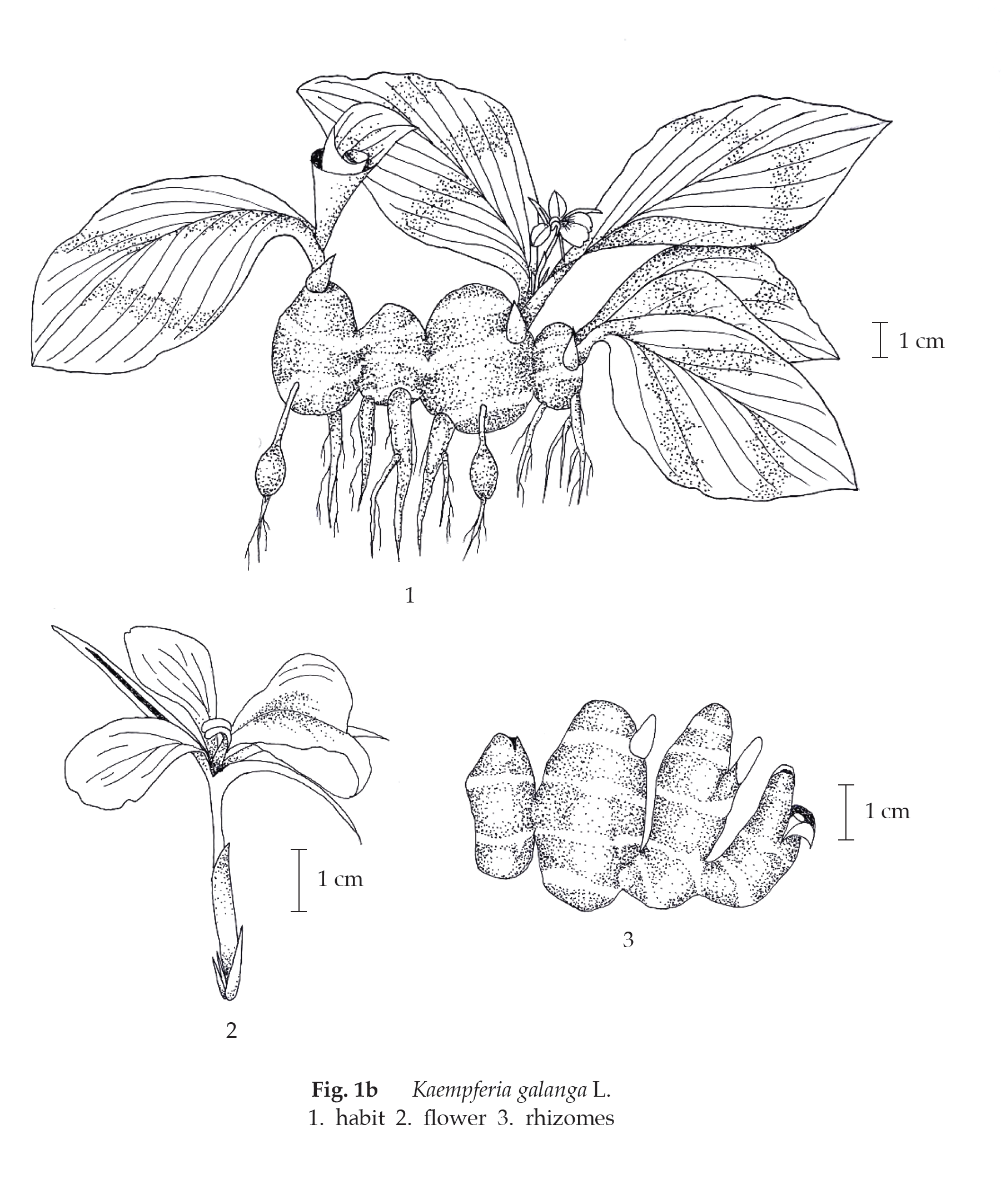
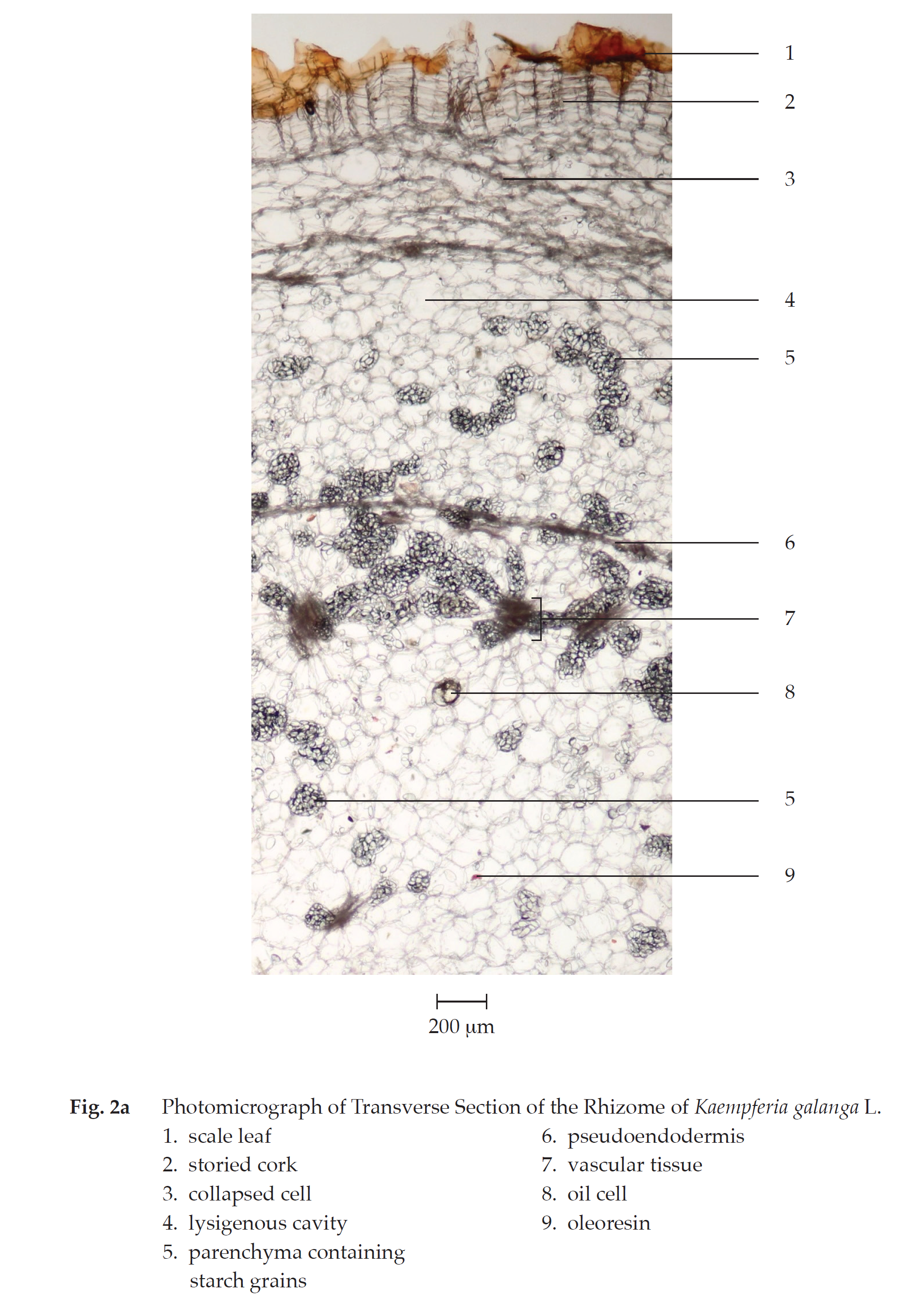
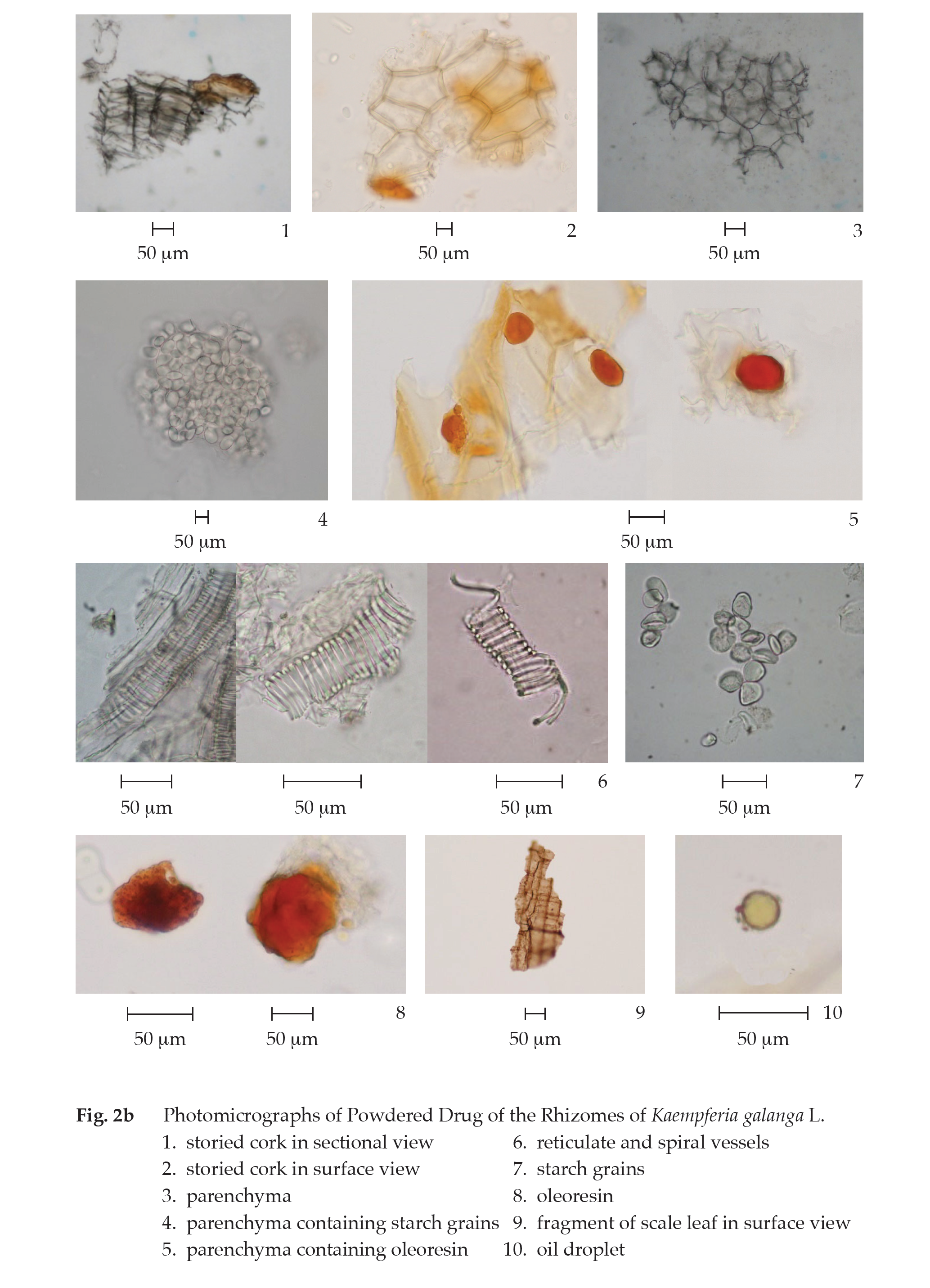
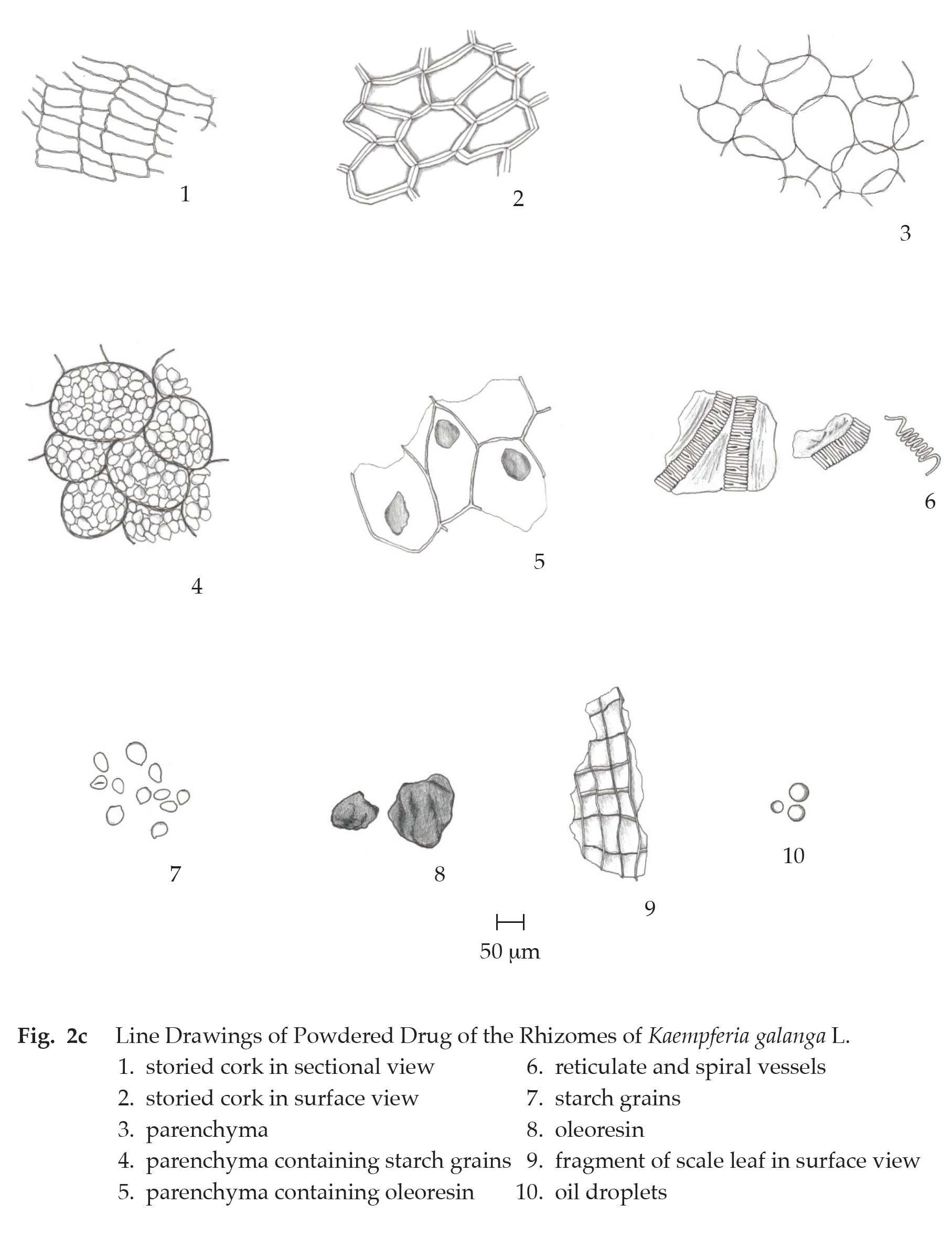
Packaging and storage Kaempferia Galanga Rhizome shall be kept in well-closed containers, preferably of metal or glass, protected from light and stored in a cool and dry place.
Identification
A. Sonicate 2 g of the sample, in moderately fine powder, with 10 mL of methanol for 10 minutes and filter (solution 1). To 2 mL of solution 1, add a few drops of ninhydrin TS and heat on a water-bath: a violet colour is produced.
B. To 2 mL of solution 1, add a few drops of vanillin-sulfuric acid TS2: a violet colour is produced immediately.
C. Carry out the test as described in the “Thin-Layer Chromatography” (Appendix 3.1), using silica gel F254 as the coating substance and a mixture of 90 volumes of toluene and 10 volumes of ethyl acetate as the mobile phase. Apply separately to the plate as bands of 8 mm, 10 µL of solution (A) and 12 µL of solution (B). Prepare solution (A) by sonicating 1 g of the sample, in moderately fine powder, with 10 mL of methanol for 30 minutes and filtering. Evaporate the filtrate to dryness under reduced pressure at 50°. Dissolve the residue in 1 mL of methanol. For solution (B), dissolve 1 mg of ethyl trans-4-methoxycinnamate in 1 mL of methanol. After removal of the plate, allow it to dry in air and examine the plate under ultraviolet light (254 nm), marking the quenching bands. The chromatogram obtained from solution (A) shows a quenching band (hRf value 47 to 51) corresponding to the ethyl trans-4-methoxycinnamate band from solution (B), and several other quenching bands are also observed. Examine the plate under ultraviolet light (366 nm); the band due to ethyl trans- 4-methoxycinnamate exhibits a blue fluorescence. One blue fluorescent band is also observed. Subsequently spray the plate with anisaldehyde TS and heat at 105° for 10 minutes; the band corresponding to ethyl trans-4-methoxycinnamate is purple. One brown, two orange and nine purple bands are also observed (Fig. 3).
Water Not more than 11.0 per cent v/w (Azeotropic Distillation Method, Appendix 4.12).
Foreign matter Not more than 2.0 per cent w/w (Appendix 7.2).
Acid-insoluble ash Not more than 2.0 per cent w/w (Appendix 7.6).
Total ash Not more than 8.0 per cent w/w (Appendix 7.7).
Ethanol-soluble extractive Not less than 2.5 per cent w/w (Appendix 7.12).
Water-soluble extractive Not less than 14.0 per cent w/w (Appendix 7.12).
Volatile oil Not less than 4.0 per cent v/w, calculated on the anhydrous basis (Appendix 7.3H). Use 15 g, in moderately fine powder, freshly prepared and accurately weighed. Use 200 mL of water as the distillation liquid and a 500-mL round-bottomed flask. Distil at a rate of 2 to 3 mL per minute for 3 hours. Use 2.0 mL of xylene in the graduated tube.
